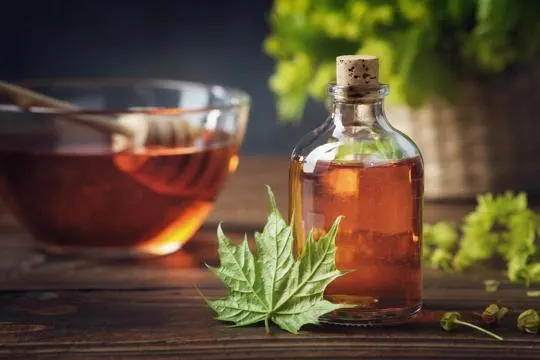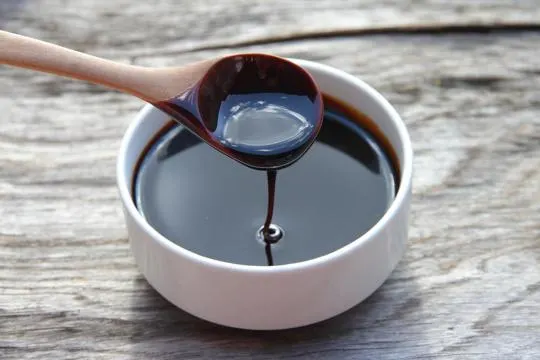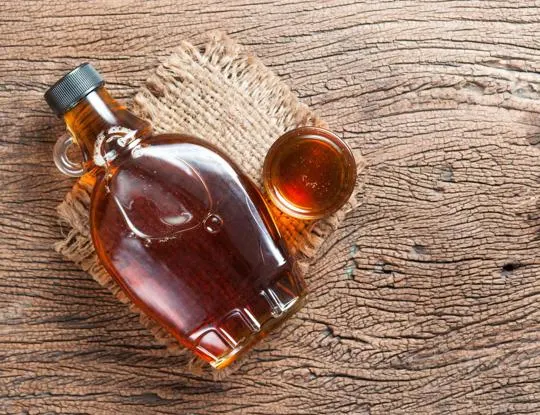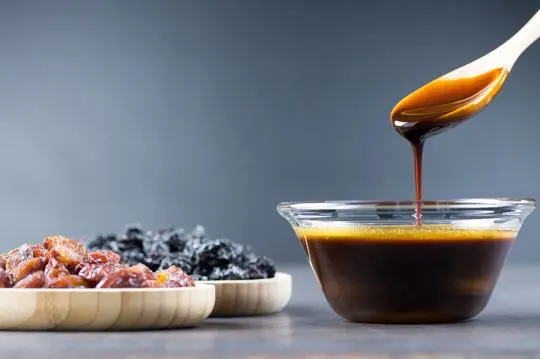Summary of key points
The main difference between maple syrup and molasses lies in their source and taste. Maple syrup is made from the sap of maple trees and has a sweet, caramel-like flavor. Molasses, on the other hand, comes from boiling sugarcane juice and has a darker, more robust flavor.
In terms of culinary uses, maple syrup is often used as a topping for pancakes or waffles, while molasses is commonly used in baking and cooking to add depth of flavor.
Another distinction is their nutritional profiles. While both are natural sweeteners, maple syrup contains more antioxidants and minerals, while molasses has a higher iron content.
Whether you’re drizzling maple syrup on your breakfast or adding a touch of molasses to your BBQ sauce, these two syrups offer unique and delicious flavors. Just remember to use them in moderation as they are still sweeteners.
Maple syrup and molasses. We often find ourselves standing in the grocery aisle, staring at these two bottles. They’re not the same, even though they both sweeten our mornings.
Maple syrup, that sweet tree juice, taps directly from the maple tree. It’s like nature’s candy. On the other hand, molasses is the dark, rich byproduct of refining sugar cane or beet into sugar.
We’ve all been there, trying to decide which bottle to take home. Will it be the golden hue of maple syrup or the deep, robust molasses?
Each has its own unique flavor profile and uses in our kitchens.
What is Maple Syrup?

Maple syrup, famous for its sweet taste, is a yummy choice for adding sweetness to pancakes, waffles, and desserts.
This natural syrup is made by boiling the sap of maple trees until it becomes a golden liquid.
To make the syrup, you tap the trees and collect the sap, then heat it until it thickens.
This scrumptious sweetener not only tastes good but also provides minerals like manganese and zinc.
Unlike refined sugar or artificial sweeteners, maple syrup isn’t much processed, so it keeps some of its natural compounds.
Antioxidants are among these compounds, which can help safeguard our cells from harm caused by free radicals.
Also, maple syrup has different flavors depending on its grade.
It’s usually classified into darker or lighter grades based on color and taste intensity.
The lighter grades have a milder flavor with notes of vanilla, and the darker grades have a more caramelized flavor.
It’s important to know that maple syrup still has sugar, so it’s best to eat it in moderation.
Enjoying this tasty treat too often isn’t recommended, and portion control is key.
What is Molasses?

Molasses is a sweet and thick syrup, created as a byproduct of the sugar-making process.
You get it when sugar cane or sugar beets are crushed and their juice is boiled down.
Molasses has a dark brown color and a strong flavor, making it a great addition to many dishes.
It comes in different types, each with its own taste.
Light molasses is made from the first boiling of the juice and is milder.
Dark molasses is from the second boiling and has a stronger flavor.
Blackstrap is from the third boiling and is very bittersweet.
Molasses is also good for you.
It contains minerals like iron, calcium, potassium, and magnesium.
It is also full of antioxidants that fight free radicals.
So, molasses brings unique flavor and nutrition.
Consider adding it to your recipes or as an alternative to traditional sweeteners.
Differences Between Maple Syrup and Molasses

Maple syrup and molasses are two distinct natural sweeteners.
Maple syrup comes from the sap of maple trees, while molasses is a byproduct of sugar production.
Although both have a rich and complex flavor, there are differences.
Source and Production
Maple syrup and molasses are both natural sweeteners with unique flavors and origins.
Maple syrup is obtained from sap of maple trees found mainly in North America.
It’s created by evaporating the sap to create the syrup.
Color can vary from light amber to dark robust.
Molasses is a byproduct of sugar-making.
It’s made by boiling sugarcane or beet juice until it becomes a thick syrup.
This liquid is later crystallized to make refined sugar.
It is available in three forms: light, dark, and blackstrap.
Each has its own flavor.
Though both are sweeteners, they vary in nutritional composition.
Maple syrup is packed with minerals like manganese and zinc plus antioxidants.
Molasses is rich in iron and calcium.
So, explore these natural sweeteners for your favorite dishes.
They both add sweetness and depth – it’s up to you to decide which flavor you prefer.
Taste and Flavor Profile
Maple syrup and molasses: two classic sweeteners that are often pitted against each other in baking and cooking recipes.
But how do they really compare in terms of taste and flavor?
Maple syrup is known for its distinctive sweetness and subtle vanilla notes, with a touch of smokiness.
Molasses, on the other hand, offers a deeper and more complex profile with a rich, bittersweet flavor and a hint of caramel.
While both sweeteners are great natural substitutes for refined sugars, they possess different unique qualities that make them stand out in any culinary preparation, from desserts to marinades and glazes.
It all boils down to personal preference, as the flavor profile of maple syrup and molasses complements different foods and drinks in various ways.
So, next time you find yourself in a sweet dilemma, use this information to make an informed decision for your next culinary masterpiece.
Color and Viscosity
Color and Viscosity: Maple syrup and molasses can be seen as twins – but they’re not quite the same.
Maple syrup has a golden amber hue, whereas molasses is dark brown or black.
Maple syrup’s thin texture makes it more effortless to pour over pancakes or waffles, while molasses is thicker and stickier – perfect for baking or adding depth to savory dishes.
The different colors come from different production processes: maple syrup from maple tree sap boiled down to concentrate the sweetness, and molasses from refining sugar cane or sugar beets.
To sum up, color and viscosity are key features that set these two syrups apart.
Knowing the differences helps you pick the right sweetener for your culinary creations.
Nutritional Composition
Maple syrup and molasses appear similar, yet their nutritional makeup is very different.
Maple syrup is extracted from the sap of maple trees.
It contains minerals like calcium, zinc, and potassium; plus antioxidants which can help battle inflammation.
Molasses is a by-product of the sugar refining process.
It is high in minerals such as iron, manganese, and copper.
It has more calories than maple syrup, but it also has its own health benefits.
Maple syrup’s taste is lighter and sweeter, whereas molasses has a strong, robust flavor.
If you are searching for a natural sweetener or an ingredient with a strong flavor, it’s important to understand the differences between maple syrup and molasses.
That way you can make educated choices in your cooking.
Similarities Between Maple Syrup and Molasses

Both sweeteners are used in cooking and baking.
They have a deep, complex flavor which adds a unique taste to dishes.
Both are sweet, but offer a hint of bitterness or earthiness.
They can be used as toppings for pancakes, waffles, or French toast.
As natural sweeteners, they can also be used in desserts like cookies, cakes, and muffins.
In addition, they can be added to glazes for meats or vegetables.
Nutritionally, they are both high in sugars and contain trace amounts of minerals.
Iron, calcium, potassium, and magnesium can be found, but may not contribute a lot to daily intake.
To conclude, maple syrup and molasses have similar flavor profiles and can be used in the same recipes.
However, you should consider their specific characteristics before deciding which one to use.
Culinary Uses and Pairings
Maple syrup and molasses have a variety of uses.
Maple syrup is great on breakfast favorites like pancakes, waffles, and oatmeal.
It also sweetens desserts such as ice cream and baked goods.
Molasses, on the other hand, adds complexity to sauces, marinades, and savory dishes like barbecue sauce and gingerbread cookies.
Plus, it pairs well with spices like cinnamon, ginger, and cloves.
Maple syrup is a great glaze for meats like ham or salmon.
It can also be drizzled over roasted vegetables for a sweet, umami flavor.
Molasses can be added to marinades for grilled chicken or pork ribs.
Plus, it can be mixed into glazes for roasted vegetables.
Additionally, maple syrup can be used as a sugar substitute in dressings, vinaigrettes, and marinades.
It’s a great way to add flavor without overpowering other ingredients.
Molasses can be brushed on top of baked goods before they go into the oven for an extra layer of richness.
In conclusion, both maple syrup and molasses make wonderful additions to recipes.
Experimenting with these syrups is a great way to create unique taste experiences in the kitchen.
Conclusion
To sum it up, maple syrup and molasses are both popular sweeteners with different flavors.
Maple syrup comes from the sap of maple trees, while molasses is made from sugar cane or sugar beet juice.
Maple syrup has a delicate sweetness, while molasses has a robust, slightly bitter taste.
Nutritionally, maple syrup has antioxidants and minerals like manganese and zinc, while molasses is an excellent source of iron and calcium.
Both can be used in cooking, baking, and as toppings.
Ultimately, it’s all about personal preference and the flavor you want for your dish.
Either way, these sweeteners offer a distinct taste that can make your meals even better.

Leave a comment